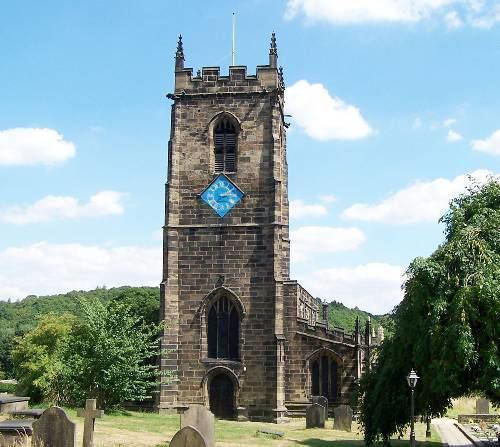Population 3,153 (2011) Civil parish Silkstone | OS grid reference SE289058 Local time Tuesday 8:38 PM | |
 | ||
Weather 4°C, Wind S at 14 km/h, 84% Humidity | ||
Silkstone is a village and civil parish in the Metropolitan Borough of Barnsley in South Yorkshire, England. It is situated in the foothills of the Pennines, between the towns of Barnsley and Penistone, and includes the village of Silkstone Common. At the 2001 census it had a population of 2,954, increasing to 3,153 at the 2011 Census.
Contents
Map of Silkstone, UK
Silkstone Parish is twinned with Saint-Florent-des-Bois in France.
History
The name Silkstone is Old English in origin and is thought to derive from the Anglo-Saxon man's name Sylc and the suffix tūn meaning a farmstead, giving "Sylc's farmstead". The earliest known written record of Silkstone is the Domesday Book of 1086, when Silkstone is referred to as a part of the manor of Cawthorne:
In Calthorne (Cawthorne) Ailric had three carucates of land to be taxed and there may be two ploughs there. The same now has it of Ilbert; himself two ploughs there, and four villanes with two ploughs. There is a vicor and a church, wood pasture two miles long and two broad; the whole manor three miles long and two broad. Value in King Edward's time forty shillings, now twenty shillings. To this manor belongs Silchestone, one carucate and a half.
The church mentioned may be a predecessor of the current Church of All Saints, the parish church in Silkstone. Silkstone parish originally included Cawthorne, West Bretton, Cumberland, Barnsley, Dodworth, Stainborough, Thurgoland, and Hoylandswaine.
The Silkstone coal seam is at its shallowest in the Silkstone area, and mining was an important local industry. In 1809 a waggonway was built through the village by the Barnsley Canal Navigation Company. The waggonway was used to transport coal from collieries in the Silkstone valley to Cawthorne. A memorial commemorating the waggonway stands in the village.
Sport
The village has sporting facilities, in the shape of the Pavilion. It is host to both a football and cricket team, with both sports being played at junior and senior levels. Silkstone is frequented by ramblers as many walking routes start from the village.
Culture and attractions
The Church of All Saints was constructed in the 12th century (with alterations/renovations in the 15th and 19th centuries), it is a Grade I listed building. It is locally known as the minster of the moors. The Grade II listed Noblethorpe Hall near the village was built in the early 19th century for the Clarke family (local colliery owners). During the Second World War it was used as an army camp. Pot House Hamlet is located below Silkstone Church and was the site of a 17th-century pottery and 18th century glassworks. English Heritage have deemed this an underground national ancient monument. Pot House Hamlet today houses many independent retail outlets.
One of the village's famous sons was John Charles Brooke, Esq, FSA (1748–1794) who became Somerset Herald in 1777. He was crushed to death in a crowd at the Haymarket Theatre in London on 3 February 1794.
The Wagonway runs through Silkstone and also as far as its neighbouring village Cawthorne, it was used as a route for the transportation of coal from the nearby mines. The sleeper stones were originally laid in the early 19th century when coal mining was booming, and was used throughout until the 20th century. The stones can still be from the ring o bells pub to Pot House Hamlet on the route.
Today, the Wagonway is a scenic route ideal for country walks, with storey boards, it is preserved as a historic route and is part of the village's history.
The village is also home to Old Silkstone Band. The band has a long history dating back almost 150 years. In recent times, the band has been very successful, competing for the first time in the championship section, against more famous bands like Grimethorpe and Black Dyke. (the Championship section, is the brass band version of footballs premier league!)It is a band run without major sponsporship, and is well supported by the villages of Silkstone and Silkstone Common.
Silkstone Common
Silkstone Common has Junior and Infants Schools, a railway station, a single local shop and the Station Inn.
One of the most notable events in the history of the village was the Huskar Pit Disaster, which occurred on 4 July 1838 when a freak storm flooded part of the mine, killing 26 children, the youngest was 7 years, the oldest 17. A historical account of this event has been documented in the book entitled Children of the Dark.
Notable buildings include Knabbe's Hall which was built in the late 17th century for William and Elizabeth Wood of Wortley Forge.
Silkstone Common house prices are high due to the local amenities and close proximity to Penistone Grammar School.
